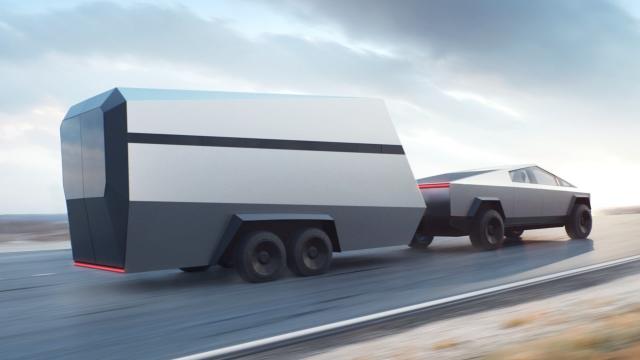Elon Musk’s Cybertruck is visionary.
[referenced url=”https://gizmodo.com.au/2019/11/tesla-cybertruck-broken-window/” thumb=”https://gizmodo.com.au/wp-content/uploads/2019/11/musk-oh-no-410×231.png” title=”Tesla Brags About Cybertruck’s Tough Windows, Metal Ball Immediately Wrecks Them” excerpt=”Earlier today Tesla finally unveiled its long awaited futuristic pickup, the Cybertruck. The metal beast looks like something straight out of a dystopian sci-fi novel. But while it looks indestructible, with Musk himself talking up how tough it was, a stage malfunction proved otherwise.”]
The “brutal, angular beast,” as our pals at Jalopnik called it, was a moment of genius for Tesla fanboys and Blade Runner-inspired-design aficionados. It’s alleged specs showed an electric car can bean aggressive speed demon that could body wimpy Priuses off the road.
But look deeper and the real vision the Cybertruck espouses is one of utter dystopia. Musk himself tweeted before it was unveiled that it was akin to a personal “armoured personnel carrier from the future.” Despite being all-electric, the Cybertruck is exactly what isn’t needed to combat the climate crisis. Joking aside about the armoured glass failure, the truck is made for a hot, violent future of haves and have nots. I suspect that’s by design.
The design of the Cybertruck may look cool (to some of us), but it also leans heavily into the idea that not only is personal transit a necessity but that huge honking trucks are the best way to get around. As Gizmodo has famously (or infamously, depending on who you ask) argued, we need to ban cars to combat climate change. More cars on the road leads to more congestion, which leads to more emissions and building more roads (which keeps the cycle going).
Just as self-driving cars aren’t exactly a slam dunk for the climate, the same goes for electric cars (or Cybertrucks). It’s great the Cybertruck is a plugin electric, but the vast majority of the U.S. grid still runs on polluting fossil fuel energy, to say nothing of countries with dirtier infrastructure. Yes, those sources are easier to regulate, but for now, they still exist. And they will continue to in 2021 when the Cybertruck is supposed to go into production.
It’s those fossil fuel sources of energy and their continued existence that perhaps provide the biggest insights into the Cybertruck design. The world has warmed about 1 degree Celsius since the Industrial Revolution. That’s led to consequential climate damages around the world. And as a recent report made clear, world leaders are making aspiration pledges to reduce future damage while planning to extract a shit-ton of fossil fuels over the coming decades.
Musk has called climate change the “biggest threat that humanity faces this century.” And to his credit, he’s done a ton of work to at least attempt to mitigate it. But he’s also accurately pointed out that “[t]oday’s refugee problem is perhaps a small indication of what the future will be like if we do not take action with respect to climate change.”
Even if the world gets its act together and somehow manages to rapidly drawdown carbon pollution in the coming decade and meet the Paris Agreement goal of keeping warming to within 2 degrees Celsius of pre-industrial levels, we’ll still lock in some pretty severe climate impacts. Seeing the destabilising effect climate change has already had, and rising anxiety around the world (particularly with the moneyed class), the Cybertruck can be seen as an opportunity to cash in on the climate chaos of the future.
A climate crisis-driven dystopia isn’t a given, but the alarm bells sure are ringing when you look at the present. Sea level rise is already causing ability to grow crops. And that’s just in the U.S.
Extrapolate that out into the future around the world, and it’s not hard to imagine a world where resources start to become more scarce, vehicles with internal combustion engines are banned, and public investment in transit (or anything for that matter) continues to falter, driving further inequality. While the super wealthy flee to New Zealand or Mars, the regular wealthy are surely going to be looking for an affordable roving fortress to fend off plebes looking for a handout. Assuming Tesla fixes the whole shatterproof glass thing, the Cybertruck with its “nearly impenetrable exoskeleton, [and] every component is designed for superior strength and endurance” would certainly fit the bill.
The $US39,900 ($58,813) base option with a 200-mile (320 km) range and rear-wheel drive for the 10 per cent, the $US69,900 ($103,033) deluxe version with 500-mile (800 km) range and all-wheel drive for the 1 per cent. The rest of us will have to Mad Max it.
Musk could also, of course, see the Cybertruck as a prototype to be perfected on Earth and used on Mars. Or it could just be marketing hype to keep Tesla in the news. But as a vision for the future of transit on Earth, it’s as dark as it is unique. It’s one that not only replicates past failures, but weaponises them for an increasingly hot, dangerous future.
